Search results for: 'Addin'
- Related search terms
- Adding
-
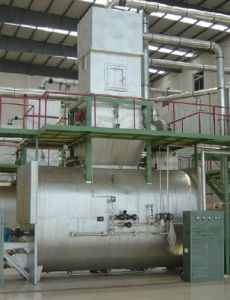 H-1261 GOOSE FEATHER CLEANING MACHINE
H-1261 GOOSE FEATHER CLEANING MACHINEH-1261 GOOSE FEATHER CLEANING MACHINE
LIST OF COMPONENTS FOR THE GOOSE FEATHER CLEANING MACHINE:
1) RINSING MACHINE OF THE TYPE 2000 (STAINLESS STEEL USED FOR IT)
EXTERIOR DIMENSION: 4000×2000×2600×Ф1800MM
QUANTITY: 12) GOOSE FEATHER ADDING MACHINE
EXTERIOR DIMENSION: 4000×1800×3300MM
QUANTITY: 13) WATER TANK
EXTERIOR DIMENSION: Ф1930MM×2440MM
QUANTITY: 14) DEWATERING MACHINE FLAT PLATE TYPE (BEING EQUIPPED WITH VARIABLE FREQUENCY CONTROL) - 2 SETS
QUANTITY: 25)DRYER OF THE TYPE 2000 (BEING EQUIPPED WITH ELECTRONIC WEIGHING)
EXTERIOR DIMENSION: 4500×2100×2900MM
QUANTITY: 16)GOOSE FEATHER ADDING MACHINE FOR DRYER(STAINLESS STEEL USED FOR IT AND ELECTRONIC WEIGHING INCLUDED)
EXTERIOR DIMENSION: 1500×1200×3600MM
QUANTITY: 17)THE COOLER OF THE TYPE 4700(STEEL & WOOD STRUCTURE, OPTIMIZED MOISTURE PROOF PANEL)
EXTERIOR DIMENSION: 4700×2350×2600×Ф2000MM
QUANTITY: 18) SORTING EQUIPMENT
QUANTITY: 29) POWER DISTRIBUTION CABINET
QUANTITY: 2RINSING MACHINE: TYPE 2000
1. EXTERIOR DIMENSION: 4000×2000×2600×Ф1800MM DIAMETER
2.THE MATERIAL OF 14MM IN THICKNESS STAINLESS STEEL IS USED FOR THE WALL FOR WASHING MACHINE AND 5MM IN THICKNESS FOR BARREL
3. THE MATERIAL OF AISI 1045 IS USED FOR THE SPINDLE OF THE SQUARE SHAPE(SPECIFICATION =108MMX108MM). WRAPPED WITH 2MM STAINLESS STEEL IN THE OUTER.
10MM IN THICKNESS STAINLESS STEEL IS FOR HOOP OF VANE.
4MM IN THICKNESS STAINLESS STEEL WHICH IS FOLDED IS FOR VANE.
HOOP SCREW OF M14 X 70 (HIGH STRENGTH GRADE) ARE USED.
THE BEARING HOUSING &BEARING OF UKP318 IS USED FOR THE SPINDLE.4.THE SIEVE OF 1.5MM IN THICKNESS STAINLESS STEEL IS USED FOR WACHING MACHINE.THE HOLE IS 1.8MM IN DIAMETER. HOLE SPACING 3.8MM .THE STAINLESS STEEL OF 2MM IS USED FOR THE OBLIQUE OF OUTPUTTING THE GOOSE FEATHER.THE OUTLET NEAR DEWATERING MACHINE FOR GOOSE FEATHER CAN BE TURNED UPWARD. FOR GOOSE FEATHER.
5.THE PIPE FOR WATER INLET IS 114MM IN DIAMETER
6.THE POWER OF FAN: 7.5KW AND SPEED: 2900R/M
7.THE PIPE FOR FEEDING GOOSE FEATHER IS 250MM IN DIAMETER.
8.THE REDUCER FOR THE SPINDLE: JZQ-400. THE POWER OF MOTOR IS 15KW AND OUTPUT SPEED IS 42 R/M
9.EXTERIOR DIMENSION OF THE BOTTOM FOR WASHING MACHINE: WIDTH=1600MM;LENGTH=3500MM.ONE SIEVE OF 1MM IN THICKNESS FOR IT.
WATER TANK
1. THE DIMENSION OF TANK: Ф1930MM×2440MM
2.THE STAINLESS STEELOF 2MM IN THICKNESS FOR ITS BARREL AND 3MM FOR THE BOTTOM.THE COVER IS CONSTUCTED WITH ANGLE IRON OF STAINLESS STEEL AND INNER COVER 2MM STAINLESS STEEL PLATE.
DEWATERING MACHINE OF TYPE 1600
1. ONE SETS OF RINSING MACHING OF THE TYPE 2000 IS EQUIPPED WITH TWO SETS DEWATERING MACHINE OF THE TYPE 1600
2.THE POWER OF MOTOR=11KW-17KW.DOUBLE SPEED MOTOR WITH VARIABLE FREQUENCY CONTROL.
DRYER OF TYPE 2000
1. EXTERIOR DIMENSION: 4500×2100×2900×Ф1800MM(DIAMETER)
2. THE MATERIAL OF 14MM IN THICKNESS STAINLESS STEEL(Q345R) IS USED FOR THE WALL FOR WASHING MACHINE. 10MM STAINLESS STEEL(Q345R) IS USED FOR INNER COVER OF THE BARREL AND 10MM STAINLESS STEEL (Q345R) PLATE FOR OUTER COVER OF THE BARREL.
3. THE INNER WALL OF WIND PLATE IS 0.5MM IN THICKNESS AND THE HOLE 1.5MM IN DIAMETER STAINLESS STEEL. 3MM COLD ROLLED PLATE IS USED FOR THE OUTER GATE.
4. THE SEAMLESS PIPE OF Ф108MM×10MM IS FOR THE MAIN SPINDLE.THE STEEL PLATE OF 10MM IN THICKNESS IS FOR THE VANE.THE WIDTH OF THE VANE IS 80MM. HOOP SCREW IS M12X70
6. THERE ARE FOUR INLET OF 1.5INCH IN DIAMETER FOR STEAM.
RELIEF VALVE FROM 3 KILO TO 7 (1 SETS)
THE PRESSURE GAGE (0-16 KILO) (2 SETS)
THE THERMOMETER (0-150 DEGREE) (1 SETS)
THERE ARE THREE DRAIN HOLE OF 1.5 INCH IN DIAMETER AT THE BOTTOM6. THERE ARE TWO LAYERS FOR GOOSE FEATHER ADDING FOR DRYER: 1.5×1.2×3.6M.THEY ARE MADE WITH STAINLESS STEEL.THE SPECIFICATION OF CHARGING SPOUT ON THE TOP OF DRYER IS 1.55 X 0.55M.
7. THE OUTLET FOR GOOSE FEATHER OF DRYER CAN BE TURNED UPWARD.THE PIPE FOR OUTPUTTING GOOSE FEATHER IS 300MM IN DIAMETER.
8. TWO FANS ARE EQUIPPED FOR PRECISE WASHING LINE.THE POWER OF FAN FOR ADDING GOOSE FEATHER IS 7.5KW,SPEED: 2900R/M.WHICH IS USED TOGETHER WITH GOOSE ADDING MACHINE OF WASHING MACHINE.THE POWER OF FAN FOR DRYER IS 5.5KW,SPEED IS 2900 R/M.
9. MAIN SHAFT SPEED REDUCER FOR BELT BRIDGE MOTOR 7.5KW.OUTPUT SPEED IS 52 R/M
THE COOLER IS OF TYPE 47001. EXTERIOR DIMENSION: 4700×2350×2600×Ф2000MM DIAMETER
2. THE EXTERIOR IS CONSTRUCTED WITH THE WHOLE WOOD STRUCTURE.THE MATERIAL OF STEEL WITH 4# ANGLE STEEL AND 30X30 SQUARE TUBE IS FOR THE INNER SKELETON.
3. THE SEAMLESS PIPE OF Ф108MM×10MM IS FOR THE MAIN SPINDLE.THE STEEL PLATE OF 14MM IN THICKNESS IS FOR THE VANE.THE WIDTH OF THE VANE IS 80MM. HOOP SCREW IS M16X70
4. THE DIAMETER OF WIND PIPE: MAIN PIPE IS 300MM IN DIAMETER AND BRANCH IS 250MM IN DIAMETER.THERE ARE FOUR AIR OUTLET OF 300MM IN DIAMETER EQUIPPED EQUALLY SPACE.
5. ONE SIEVE IS EQUIPPED FOR THE COOLER.THE SIEVE IS MADE WITH 0.6MM IN THICKNESS GALVANIZED STEEL SHEET.THE HEIGHT OF HOLE IS 1.1MM.THE SCREEN FRAME IS MADE WITH 3# ANGLE STEEL.
6.THERE ARE TWO SORTING BOX WHICH IS CONSTRUCTED WITH STEEL FRAME AND WOODEN STRUCTURE. SIEVE 14 MESH GALVANIZED MESH BOLD
7. ONE FAN IS FOR THE COOLER.THE POWER OF THE FAN IS 11KW AND OUTPUT SPEED IS 2900 R/M
8. THE MOTOR FOR THE MAIN SPINDLE IS 15KW (6 POLE).THE SPEED OF 140 R/M IS FOR THE COOLER.
QUANTITY: 1
Learn More -
 TT-7724 CYKLOP BOTTLING LINE FOR BABY POWDER MILK 18000 CPH, YEAR 2000TT-7724 CYKLOP BOTTLING LINE FOR BABY POWDER MILK 18000 CPH, YEAR 2000 1. BOTTLING LINE FOR BABY POWDER MILK 18000 CPH 2. BRAND: CYKLOP 3. YEAR: 2000 4. SPEED: 18000 CANS/HOUR 5. PRODUCTS: DAIRY 6. CONTAINERS: CAN Learn More
TT-7724 CYKLOP BOTTLING LINE FOR BABY POWDER MILK 18000 CPH, YEAR 2000TT-7724 CYKLOP BOTTLING LINE FOR BABY POWDER MILK 18000 CPH, YEAR 2000 1. BOTTLING LINE FOR BABY POWDER MILK 18000 CPH 2. BRAND: CYKLOP 3. YEAR: 2000 4. SPEED: 18000 CANS/HOUR 5. PRODUCTS: DAIRY 6. CONTAINERS: CAN Learn More -
 L-3886 CHICKEN FEED PRODUCTION LINE
L-3886 CHICKEN FEED PRODUCTION LINEREFERENCE NUMBER: L-3886
Learn More
1) RECEIVING PROCESS
HEIGHT: 12 METERS
POWER: 1.5 KW
2) GRINDING AND MIXING PROCESS
LENGTH: 1.5 METERS
POWER: 1.5 KW
3) PELLETIZING AND BAGGING PROCESS
CAPACITY: 2 TO 3 TONS PER HOUR, PER UNIT
POWER: 37 KW
4) AUXILIARY PROCESS
POWE: 1.5 KW
5) ELECTRIC CONTROL SYSTEM
POWER: 3 PHASE, 380 VOLTS, 50 Hz -
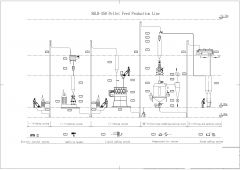 M-0652 CHICKEN FEED MILL-500 TO 1000 KG PER HOURREFERENCE NUMBER: M-0652 CHICKEN FEED MILL-500 TO 1000 KG PER HOUR MODEL: 250 500 TO 1000 KG PER HOUR QUANTITY AVAILABLE: 1 Learn More
M-0652 CHICKEN FEED MILL-500 TO 1000 KG PER HOURREFERENCE NUMBER: M-0652 CHICKEN FEED MILL-500 TO 1000 KG PER HOUR MODEL: 250 500 TO 1000 KG PER HOUR QUANTITY AVAILABLE: 1 Learn More -
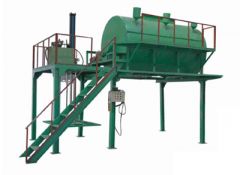 E-9553 FOAM RE-BONDING MACHINEREFERENCE NUMBER: E-9553 FOAM RE-BONDING MACHINE FOAM AFTER SHREDDING IS BLOWN INTO MIXING DRUM OF FOAM RE-BONDING MACHINE AFTER MIXING WITH ADHESIVE, THE MIXTURE IS DROPPED DOWN INTO A STANDARD SIZE MOLD L2M × W1.55M × H1.2M WHERE IT GOES UNDER HYDRAULIC PRESSURE TO SHAPE BONDED FOAM. AUTOMATIC RE-BONDING MACHINE WITH A STEAM CAN PRODUCE FOAM 5 TIMES AS FAST AS ONE WITHOUT STEAM. QUANTITY AVAILABLE: 1 Learn More
E-9553 FOAM RE-BONDING MACHINEREFERENCE NUMBER: E-9553 FOAM RE-BONDING MACHINE FOAM AFTER SHREDDING IS BLOWN INTO MIXING DRUM OF FOAM RE-BONDING MACHINE AFTER MIXING WITH ADHESIVE, THE MIXTURE IS DROPPED DOWN INTO A STANDARD SIZE MOLD L2M × W1.55M × H1.2M WHERE IT GOES UNDER HYDRAULIC PRESSURE TO SHAPE BONDED FOAM. AUTOMATIC RE-BONDING MACHINE WITH A STEAM CAN PRODUCE FOAM 5 TIMES AS FAST AS ONE WITHOUT STEAM. QUANTITY AVAILABLE: 1 Learn More -
 J-5377 TETRA PAK ICE CREAM PLANT, 1500 LITERS PER HOUR, YEAR 2024J-5377 TETRA PAK ICE CREAM PLANT, 1500 LITERS PER HOUR, YEAR 2024 TETRA PAK ICE CREAM PLANT ALL STAINLESS STEEL INCLUDES GANTRY LIFT OUT: TBC 1500 LITERS PER HOUR YEAR: 2024 QUANTITY: 1 Learn More
J-5377 TETRA PAK ICE CREAM PLANT, 1500 LITERS PER HOUR, YEAR 2024J-5377 TETRA PAK ICE CREAM PLANT, 1500 LITERS PER HOUR, YEAR 2024 TETRA PAK ICE CREAM PLANT ALL STAINLESS STEEL INCLUDES GANTRY LIFT OUT: TBC 1500 LITERS PER HOUR YEAR: 2024 QUANTITY: 1 Learn More -
 TT-5549 MONFORTS FONGS STENTER, WORKING WIDTH 2400mm, YEAR 2012TT-5549 MONFORTS FONGS STENTER, WORKING WIDTH 2400mm, YEAR 2012 MONFORTS FONGS STENTER 8 CHAMBERS OIL HEATED QUANTITY: 1 Learn More
TT-5549 MONFORTS FONGS STENTER, WORKING WIDTH 2400mm, YEAR 2012TT-5549 MONFORTS FONGS STENTER, WORKING WIDTH 2400mm, YEAR 2012 MONFORTS FONGS STENTER 8 CHAMBERS OIL HEATED QUANTITY: 1 Learn More -
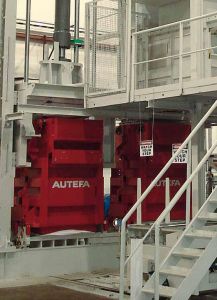 V-2151 AUTEFA, FULLY AUTOMATIC BALING PRESS MODEL LIFT BOX 1500 ADW (DOUBLE ROTATING LIFT BOXES) WITH FULLY AUTOMATIC STRAPPING AND FILM WRAPPING, YEAR 2011 – 45 BALES PER HOUR, BALE WEIGHT: 250KGS – VIDEOS AVAILABLE – NOW FULLY OPERATIONALV-2151 AUTEFA, FULLY AUTOMATIC BALING PRESS MODEL LIFT BOX 1500 ADW (DOUBLE ROTATING LIFT BOXES) WITH FULLY AUTOMATIC STRAPPING AND FILM WRAPPING, YEAR 2011 – 45 BALES PER HOUR, BALE WEIGHT: 250KGS – VIDEOS AVAILABLE – NOW FULLY OPERATIONAL – PERFECT CONDITION SHIPPING: • 3 TO 4 (40FT) CONTAINERS • OVERALL SHIPPING WEIGHT: 25 TONS (APPROXIMATELY) Learn More
V-2151 AUTEFA, FULLY AUTOMATIC BALING PRESS MODEL LIFT BOX 1500 ADW (DOUBLE ROTATING LIFT BOXES) WITH FULLY AUTOMATIC STRAPPING AND FILM WRAPPING, YEAR 2011 – 45 BALES PER HOUR, BALE WEIGHT: 250KGS – VIDEOS AVAILABLE – NOW FULLY OPERATIONALV-2151 AUTEFA, FULLY AUTOMATIC BALING PRESS MODEL LIFT BOX 1500 ADW (DOUBLE ROTATING LIFT BOXES) WITH FULLY AUTOMATIC STRAPPING AND FILM WRAPPING, YEAR 2011 – 45 BALES PER HOUR, BALE WEIGHT: 250KGS – VIDEOS AVAILABLE – NOW FULLY OPERATIONAL – PERFECT CONDITION SHIPPING: • 3 TO 4 (40FT) CONTAINERS • OVERALL SHIPPING WEIGHT: 25 TONS (APPROXIMATELY) Learn More -
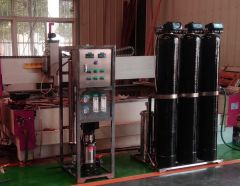 V-2042 WATER RECIRCULATION SYSTEM FOR WATERJETSV-2042 WATER RECIRCULATION SYSTEM FOR WATERJETS 6 LITERS PER MINUTE MAXIMUM JET HEAD USES 1 TO 2 LITERS PER MINUTE FILTRATION: FROM 5 TO 10 MICRONS Learn More
V-2042 WATER RECIRCULATION SYSTEM FOR WATERJETSV-2042 WATER RECIRCULATION SYSTEM FOR WATERJETS 6 LITERS PER MINUTE MAXIMUM JET HEAD USES 1 TO 2 LITERS PER MINUTE FILTRATION: FROM 5 TO 10 MICRONS Learn More -
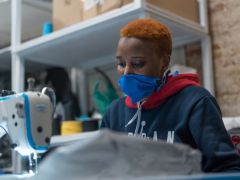 D-2388 What’s the Best Material for a Mask?
D-2388 What’s the Best Material for a Mask?Federal health officials have now recommended that we cover our faces with fabric during the coronavirus pandemic. But what material offers the most protection?
The Centers for Disease Control and Prevention has posted a no-sew mask pattern using a bandanna and a coffee filter as well as a video on making masks using rubber bands and folded fabrics found at home.
While a simple face covering can reduce the spread of coronavirus by blocking outgoing germs from coughs or sneezes of an infected person, experts say there is more variation in how much homemade masks might protect the wearer from incoming germs, depending on the fit and quality of the material used.
Scientists around the country have taken it upon themselves to identify everyday materials that do a better job of filtering microscopic particles. In recent tests, HEPA furnace filters scored well, as did vacuum cleaner bags, layers of 600-count pillowcases and fabric similar to flannel pajamas. Stacked coffee filters had medium scores. Scarves and bandanna material had the lowest scores, but still captured a small percentage of particles.
If you don’t have any of the materials that were tested, a simple light test can help you decide whether a fabric is a good candidate for a mask.
“Hold it up to a bright light,” said Dr. Scott Segal, chairman of anesthesiology at Wake Forest Baptist Health who recently studied homemade masks. “If light passes really easily through the fibers and you can almost see the fibers, it’s not a good fabric. If it’s a denser weave of thicker material and light doesn’t pass through it as much, that’s the material you want to use.”
Researchers say it’s important to remember that lab studies are conducted under perfect conditions with no leaks or gaps in the mask, but the test methods give us a way to compare materials. And while the degree of filtration for some homemade masks seems low, most of us — who are staying home and practicing social distancing in public — don’t need the high level of protection required for medical workers. More important, any face covering is better than none, especially if worn by a person who has the virus but doesn’t know it.
The biggest challenge of choosing a homemade mask material is to find a fabric that is dense enough to capture viral particles, but breathable enough that we can actually wear it. Some items being touted online promise high filtration scores, but the material would be unwearable.
Dressing Up for Work … at Home
Yang Wang, an assistant professor of environmental engineering at Missouri University of Science and Technology, worked with his graduate students to study various combinations of layered materials — including both air filters and fabric. “You need something that is efficient for removing particles, but you also need to breathe,” said Dr. Wang, who last fall won an international award for aerosol research.To test everyday materials, scientists are using methods similar to those used to test medical masks, which everybody agrees should be saved for medical workers who are exposed to high doses of virus from seeing infected patients. The best medical mask — called the N95 respirator — filters out at least 95 percent of particles as small as 0.3 microns. By comparison, a typical surgical mask — made using a rectangular piece of pleated fabric with elastic ear loops — has a filtration efficiency ranging from 60 to 80 percent.
Dr. Wang’s group tested two types of air filters. An allergy-reduction HVAC filter worked the best, capturing 89 percent of particles with one layer and 94 percent with two layers. A furnace filter captured 75 percent with two layers, but required six layers to achieve 95 percent. To find a filter similar to those tested, look for a minimum efficiency reporting value (MERV) rating of 12 or higher or a microparticle performance rating of 1900 or higher.
The problem with air filters is that they potentially could shed small fibers that would be risky to inhale. So if you want to use a filter, you need to sandwich the filter between two layers of cotton fabric. Dr. Wang said one of his grad students made his own mask by following the instructions in the C.D.C. video, but adding several layers of filter material inside a bandanna.
Dr. Wang’s group also found that when certain common fabrics were used, two layers offered far less protection than four layers. A 600 thread count pillow case captured just 22 percent of particles when doubled, but four layers captured nearly 60 percent. A thick woolen yarn scarf filtered 21 percent of particles in two layers, and 48.8 percent in four layers. A 100 percent cotton bandanna did the worst, capturing only 18.2 percent when doubled, and just 19.5 percent in four layers.
The group also tested Brew Rite and Natural Brew basket-style coffee filters, which, when stacked in three layers, showed 40 to 50 percent filtration efficiency — but they were less breathable than other options.
If you are lucky enough to know a quilter, ask them to make you a mask. Tests performed at the Wake Forest Institute for Regenerative Medicine in Winston-Salem, N.C., showed good results for homemade masks using quilting fabric. Dr. Segal, of Wake Forest Baptist Health, who led the study, noted that quilters tend to use high-quality, high-thread count cotton. The best homemade masks in his study were as good as surgical masks or slightly better, testing in the range of 70 to 79 percent filtration. Homemade masks that used flimsier fabric tested as low as 1 percent filtration, Dr. Segal said.
The best-performing designs were a mask constructed of two layers of high-quality, heavyweight “quilter’s cotton,” a two-layer mask made with thick batik fabric, and a double-layer mask with an inner layer of flannel and outer layer of cotton.
Bonnie Browning, executive show director for the American Quilter’s Society, said that quilters prefer tightly woven cottons and batik fabrics that stand up over time. Ms. Browning said most sewing machines can handle only two layers of fabric when making a pleated mask, but someone who wanted four layers of protection could wear two masks at a time.
Ms. Browning said she recently reached out to quilters on Facebook and heard from 71 people who have made a combined total of nearly 15,000 masks. “We quilters are very much in the thick of what’s going on with this,” said Ms. Browning, who lives in Paducah, Ky. “One thing most of us have is a stash of fabric.”
People who don’t sew could try a folded origami mask, created by Jiangmei Wu, assistant professor of interior design at Indiana University. Ms. Wu, who is known for her breathtaking folded artwork, said she began designing a folded mask out of a medical and building material called Tyvek, as well as vacuum bags, after her brother in Hong Kong, where mask wearing is common, suggested it. (DuPont, the maker of Tyvek, said in a statement that Tyvek is intended for medical apparel, not masks.) The folded mask pattern is free online, as is a video demonstrating the folding process. In tests at Missouri University and University of Virginia, scientists found that vacuum bags removed between 60 percent and 87 percent of particles. But some brands of vacuum bags may contain fiberglass or are harder to breathe through than other materials, and shouldn’t be used. Ms. Wu used a bag by EnviroCare Technologies, which has said it does not use fiberglass in its paper and synthetic cloth bags.
“I wanted to create an alternative for people who don’t sew,” said Ms. Wu, who said she is talking to various groups to find other materials that will be effective in a folded mask. “Given the shortage of all kinds of materials, even vacuum bags might run out.”
The scientists who conducted the tests used a standard of 0.3 microns because that is the measure used by the National Institute for Occupational Safety and Health for medical masks.
Linsey Marr, a Virginia Tech aerosol scientist and an expert in the transmission of viruses, said the certification method for respirators and HEPA filters focuses on 0.3 microns because particles around that size are the hardest to catch. While it seems counterintuitive, particles smaller than 0.1 microns are actually easier to catch because they have a lot of random motion that makes them bump into the filter fibers, she said.
“Even though coronavirus is around 0.1 microns, it floats around in a wide range of sizes, from around 0.2 to several hundred microns, because people shed the virus in respiratory fluid droplets that also contain lots of salts and proteins and other things,” said Dr. Marr. “Even if the water in the droplets fully evaporates, there’s still a lot of salt and proteins and other gunk that stays behind as solid or gel-like material. I think 0.3 microns is still useful for guidance because the minimum filtration efficiency will be somewhere around this size, and it’s what NIOSH uses.”
Learn More
